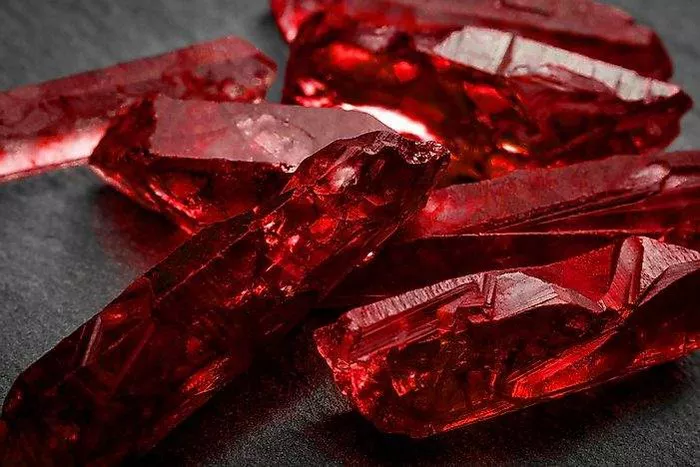Rubies are among the most coveted gemstones, prized for their intense red color and exceptional hardness. However, with the increasing popularity of synthetic and imitation gemstones, it’s essential to know how to distinguish between a real raw ruby and a fake one. By learning how to identify the characteristics of genuine rubies, you can make informed decisions when purchasing or evaluating these precious stones.
Rubies, known for their vibrant red hue, have been treasured for centuries as symbols of love, passion, and power. As with any valuable gemstone, there is a market for synthetic and imitation rubies that mimic the appearance of the real thing. Whether you’re a gemstone enthusiast, a jeweler, or a prospective buyer, being able to discern the authenticity of a raw ruby is crucial. In this article, we’ll explore the key characteristics and methods for determining whether a raw ruby is genuine or not.
Understanding Raw Rubies
Before delving into the identification process, it’s essential to have a basic understanding of what raw rubies are and how they form. Rubies are a variety of the mineral corundum, which is composed of aluminum oxide. The distinctive red color of rubies is due to the presence of chromium within the crystal structure.
Raw rubies can vary in color, clarity, and size, depending on their natural environment and geological conditions. They are typically found in igneous and metamorphic rock formations, often in association with other minerals such as garnet, spinel, and sapphire.
When evaluating a raw ruby, there are several key factors to consider:
Color: The most prized rubies exhibit a rich, intense red hue known as “pigeon’s blood” red. This color is caused by the presence of chromium and is highly sought after in the gemstone market. However, rubies can also occur in shades ranging from pinkish-red to purplish-red, with the highest value placed on those with a pure, vivid red color.
Clarity: Like other gemstones, rubies can contain inclusions, or internal imperfections, that affect their clarity. While some inclusions are acceptable and may even enhance the stone’s beauty, excessively cloudy or included rubies may be of lower quality.
Cut: The cut of a raw ruby can greatly impact its appearance and value. A well-cut ruby will exhibit brilliance and sparkle, while a poorly cut stone may appear dull or lifeless.
Hardness: Rubies are one of the hardest gemstones, scoring 9 on the Mohs scale of mineral hardness. This means they are highly resistant to scratching and abrasion, making them suitable for use in jewelry that is worn daily.
Origin: The geographic origin of a raw ruby can also influence its value and desirability. Rubies from certain locations, such as Burma (now Myanmar), Thailand, and Mozambique, are highly prized for their exceptional color and clarity.
How to Tell if a Raw Ruby Is Real
Now that we’ve covered the basics of raw rubies, let’s explore the methods for determining whether a ruby is genuine or not:
Visual Inspection: The first step in identifying a raw ruby is to visually inspect its color, clarity, and overall appearance. Genuine rubies will exhibit a vibrant red color with excellent clarity and transparency. Look for any signs of artificial coloring or surface treatments, such as dyeing or heating, which may indicate that the ruby is not natural.
Use of a Loupe or Magnifying Glass: A loupe or magnifying glass can help you examine the internal characteristics of a raw ruby more closely. Look for any natural inclusions, such as needle-like rutile or hexagonal growth lines, which are indicative of a genuine gemstone. Synthetic rubies may exhibit uniform bubble-like inclusions or flux residues that are not typically found in natural stones.
Scratch Test: As mentioned earlier, rubies are one of the hardest gemstones, making them resistant to scratching. You can perform a scratch test using a piece of quartz or corundum (such as a sapphire) to see if the ruby leaves a scratch. If the ruby is genuine, it should not be easily scratched by these harder materials.
UV Light Test: Some rubies exhibit fluorescence under ultraviolet (UV) light, which can help differentiate them from imitations. Place the ruby under a UV light source and observe any fluorescence or phosphorescence that occurs. While not all genuine rubies fluoresce, the presence of fluorescence can be a positive indication of authenticity.
Specific Gravity Test: The specific gravity of a gemstone refers to its density relative to that of water. Since rubies have a relatively high specific gravity (around 4.0), you can use this property to distinguish them from imitations. To perform a specific gravity test, weigh the ruby in air and then weigh it again while submerged in water. A genuine ruby will sink in water due to its high density, whereas most imitations will float.
Professional Certification: If you’re still unsure about the authenticity of a raw ruby, consider seeking professional certification from a reputable gemological laboratory. Gemologists can conduct a series of tests, including spectroscopy and chemical analysis, to determine the composition and origin of the ruby accurately.
Conclusion
In conclusion, determining whether a raw ruby is real requires careful examination and knowledge of its key characteristics. By understanding the visual, physical, and chemical properties of genuine rubies, you can confidently assess the authenticity of these precious gemstones. Whether you’re purchasing a ruby for personal enjoyment or investment purposes, being able to distinguish between real and fake rubies is essential for making informed decisions in the gemstone market.


